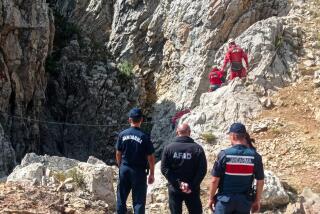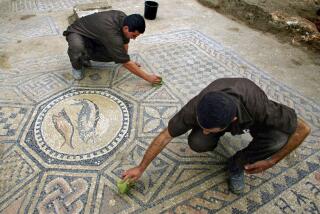High-Tech Tool Guides Dig at Prehistoric Cave in Israel
- Share via
AHIHUD, Israel — In the cool twilight of a cave once home to prehistoric humans, biologist Stephen Weiner ran a sediment sample the size of a pinhead through an infrared spectrometer.
Numbers flashed on the screen of his computer--protected against bird droppings by plastic sheets--and within seconds a printer spewed out a spectrum with the sample’s mineral composition.
Weiner, a professor at Israel’s Weizman Institute, is a pioneer in on-site analysis. His method examines the decay of wood ash in sediment to reveal the conditions for preservation of bone and other matter. The technique helps guide American, French and Israeli archeologists digging in the Hayonim Cave, or Cave of the Doves, in northern Israel.
“This is probably the only excavation in the world where we monitor in real time what is coming out of the ground,” said Weiner, who also has participated in digs in China and Greece.
The scientists were searching for remains that would shed light on the lifestyle of the Mousterians, humans who lived some 200,000 years ago in caves in the area in groups of no more than two dozen.
The dig has already yielded one of the Middle East’s largest collections of animal bones, including gazelle tarsals and the scorched shells of tortoises the Mousterians roasted on an open fire.
While biblical digs usually yield a large number of artifacts, from pottery to coins to ancient ruins, those studying the dawn of mankind have little to work with: a human skeleton if they are very lucky, stone tools, bones.
Hayonim Cave, located near the village of Ahihud five miles east of the Israeli port city of Acre, is the size of a three-story apartment building. It sits in limestone hills covered by Mediterranean scrub vegetation and olive groves.
During a recent visit, two archeology students braving the blistering noon sun stood at the mouth of the cave, shaking large sieves to separate soil from rocks. Inside the cave, an iron gangway traversed the floor from front to back.
To the left, a steep ladder descended into a large hole, the Mousterian dig. Students sitting on foam pads loosened the soil inch by inch, using hammers, chisels and small brushes.
To the right, remains of the Natufian period, dating back 13,000 years, were uncovered, including stone hearths and shelters with stone walls arranged in a circle.
Weiner’s laboratory stood in the back of the cave, next to a large work table where archeozoologist Mary Stiner from the University of Arizona at Tucson examined tiny bone fragments.
Stiner said the Mousterians lived by gathering wild plants and hunting boar, gazelles, fallow deer and tortoises.
The Mousterians used every part of the animals, skinning them with flint tools and scraping the marrow out of the bones. Stiner said she found hammerstone marks and fractures on the bones, indicating they were broken to get marrow.
Like other peoples living in the middle Paleolithic era, the Mousterians did not have pots or pans. Blackened bits of tortoise shell in Stiner’s collection are evidence that the catch of the day was roasted on the open fire.
The head of the dig, Harvard University anthropologist Ofer Bar-Yosef, said Hayonim Cave was inhabited off and on, with the Mousterians often on the move in search of food.
Bar-Yosef first looked at the cave in 1964 and returned in 1992 in hopes of finding evidence for the widely accepted assumption that modern humans evolved in Africa about 300,000 years ago and spread from there across the world.
On their way to Asia and Europe, the migrants would have had to pass through the narrow corridor of what is now Israel.
“We need to know what happened between 100,000 and 300,000 years ago. No one has found any modern fossils from this period in this part of the Middle East,” said Bar-Yosef, whose project is sponsored by the National Science Foundation in the United States, the Weizman Institute and the French Foreign Ministry.
Earlier this month, the probability of finding a human skeleton appeared very low. After analyzing nearly 100 sediment samples from the dig’s floor, about 16 feet below the original surface of the cave, Weiner was pessimistic about the chances of finding any bones, either animal or human.
Unable to bear the suspense as to whether the poor conditions would persist, the team drilled one foot farther down, skipping thousands of years of human evolution.
Weiner then analyzed the new samples and came up with good news: Conditions were more favorable for finding bone remnants.
Once, archeologists would have had to forge ahead on faith. Now, they have a much clearer idea of where the project is going.
“It’s like skipping a chapter ahead in a book,” Weiner said.
More to Read
Sign up for Essential California
The most important California stories and recommendations in your inbox every morning.
You may occasionally receive promotional content from the Los Angeles Times.













